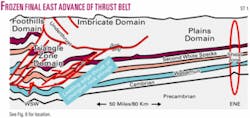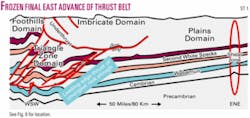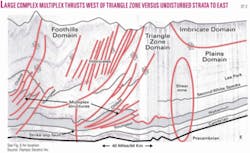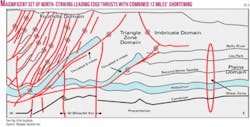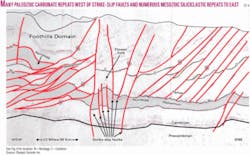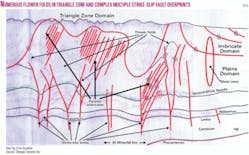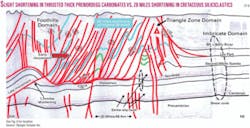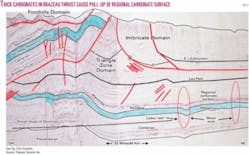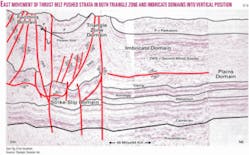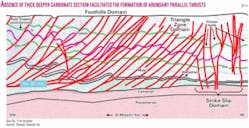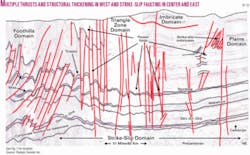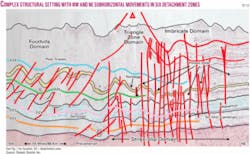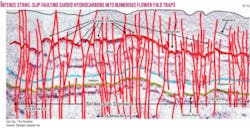This is the third of four parts on the formation of the structured belt in western Canada that encompasses the Rocky Mountains, Foothills, and the western structured portion of the Plains of Western Alberta and Northeast British Columbia.
null
null
null
Exploration/structural domains
Regional surface and subsurface data and seismic sections define six exploration/structural domains (Figs. 6 and 7). These domains are distinctly different in structural style.
The domains are, from W to E, the Thrust (divided in the Main Range, Front Range, and Foothills), Triangle Zone, Imbricate, Strike-Slip, and Plains domains. Then in the north is the Liard/Mackenzie Gravity Slide Fold Belt. Seismic transects ST 1-15 support the definition of these domains and are included in this part of the article. Each domain is described briefly in the following section and in greater detail in Part 4.
null
null
The Liard/Mackenzie Gravity Slide Fold Belt is a massive Laramide regional gravity slide. It is characterized by a series of long (100+ miles) and narrow anticlines and broad synclines, in places disrupted by strike-slip faulting.
The Thrust Domain is characterized by multitudes of updip, E-directed large and small shingled thrusts/imbricates and rollovers. Published work further divides it in three domains: The Main Range, limited east by the Pipestone Pass Thrust; the Front Range, bounded E by the McConnell Thrust; and adjacent to this the Foothills Domain.
null
null
Adjacent and E of the Foothills Domain lies the Triangle Zone Domain bounded in the W by thrusts in the Foothills and in the E by an E-dipping basal bounding underthrust of the Imbricate Domain. In places, this domain contains series of vertical to semivertical strike-slip faults and abundant flower structures. It is the front wedge of a huge body of shortened (60-100 miles) sedimentary cover that was thrust (“rock ploughed,” Fig. 11) E over the basement. Simultaneously, it ploughed E with a W-dipping leading edge thrust into and underthrusted the shallower, softer Plains sedimentary section.
null
null
Bordering the Triangle Zone Domain is the Imbricate Domain. It is characterized by a major E-dipping basal underthrust, westerly directed updip thrusts, small imbricates, and rollovers. Farther E lies the Plains Domain, characterized by gently W-dipping strata that dip beneath both Imbricate and Triangle Zone domains.
Structures trend parallel in a general NW direction, with some N-trending and W-trending stretches, in the five westernmost domains. The Strike-Slip Domain comes in from the N from underneath the Liard/Mackenzie Gravity Slide Fold Belt, in the Northwest Territories. It intersects at low angle the western Plains and both the Triangle Zone Domain and easternmost portion of the Thrust Domain. It cuts through the Deep Basin and contains numerous strike-slip faults with positive flower folds that contain abundant gas fields. Many fault blocks were skewed E due to continued pressure and thrusting from the W. It is divided into a N-S domain and a NW-SE domain.
null
null
Most structures were formed by a dynamic combination of E-thrusting and NW-SE and N-S strike-slip faulting (compression/gravity sliding and shear), in the structured belt. It created a multitude of complex structures.
Next: Conclusion-The six domains and their subareas are described in greater detail.
